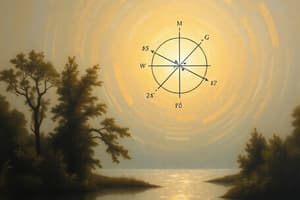Podcast
Questions and Answers
What is the relationship between the diameter and the radius of a circle?
What is the relationship between the diameter and the radius of a circle?
- Diameter is equal to the radius.
- Diameter is less than the radius.
- Diameter is twice the radius. (correct)
- Diameter is half the radius.
Which of the following formulas correctly calculates the circumference of a circle?
Which of the following formulas correctly calculates the circumference of a circle?
- C = πr/2
- C = 3.14r
- C = 2πd (correct)
- C = πr^2
What is a characteristic property of all points on a circle?
What is a characteristic property of all points on a circle?
- They are all located on the diameter.
- They are all at varying distances from the center.
- They are all equidistant from the center. (correct)
- They are all at a distance greater than the radius from the center.
Which application of circles in real life involves modeling natural processes?
Which application of circles in real life involves modeling natural processes?
How is the area of a circle calculated?
How is the area of a circle calculated?
What defines a tangent line to a circle?
What defines a tangent line to a circle?
Which of the following best describes the diameter of a circle?
Which of the following best describes the diameter of a circle?
Which of the following statements about circles is incorrect?
Which of the following statements about circles is incorrect?
Flashcards are hidden until you start studying
Study Notes
Circle
Circumference
- Definition: The distance around a circle.
- Formula: ( C = 2\pi r ) or ( C = \pi d )
- ( r ): radius
- ( d ): diameter (where ( d = 2r ))
- Pi (π) is approximately 3.14159.
Area
- Definition: The space contained within a circle.
- Formula: ( A = \pi r^2 )
- ( r ): radius
Diameter
- Definition: The longest distance across a circle, passing through the center.
- Formula: ( d = 2r )
- Represents twice the radius.
Properties Of Circles
- All points on a circle are equidistant from the center.
- The center of a circle is equidistant from any point on the circumference.
- Circles may intersect in 0, 1, or 2 points.
- A tangent to a circle is perpendicular to the radius at the point of contact.
- Chord: A segment with both endpoints on the circle; the longest chord is the diameter.
Applications In Real Life
- Engineering: Design of circular components such as wheels, gears.
- Geography: Modeling circular processes like orbits and circular boundaries for maps.
- Construction: Application in tools and fixtures, ensuring round shapes.
- Art: Circles are fundamental in various art forms and designs.
- Nature: Circular shapes in biological forms, such as cross-sections of trees and cellular structures.
Circle Circumference
- The distance around the circle is called the circumference.
- The formula for circumference is ( C = 2\pi r ) or ( C = \pi d ) where ( r ) is the radius and ( d ) is the diameter.
- The diameter is twice the radius, ( d = 2r ).
- Pi (π) is approximately 3.14159.
Circle Area
- The space contained within the circle is called the area.
- The formula for area is ( A = \pi r^2 ) where ( r ) is the radius.
Circle Diameter
- The longest distance across a circle passing through the center is called the diameter.
- The diameter is twice the radius, ( d = 2r ).
Properties of Circles
- All points on a circle are equidistant from the center.
- The center of a circle is equidistant from any point on the circumference.
- Circles can intersect in 0, 1, or 2 points.
- A tangent to a circle is perpendicular to the radius at the point of contact.
- A chord is a line segment with both endpoints on the circle, and the longest chord is the diameter.
Circle Applications
- Circles are used in engineering for designing circular components like wheels and gears.
- Circles are used in geography for modeling circular processes such as orbits and circular boundaries for maps.
- Circles are used in construction for tools and fixtures, ensuring round shapes.
- Circles are fundamental in various art forms and designs.
- Circular shapes are found in nature, such as cross-sections of trees and cellular structures.
Studying That Suits You
Use AI to generate personalized quizzes and flashcards to suit your learning preferences.




